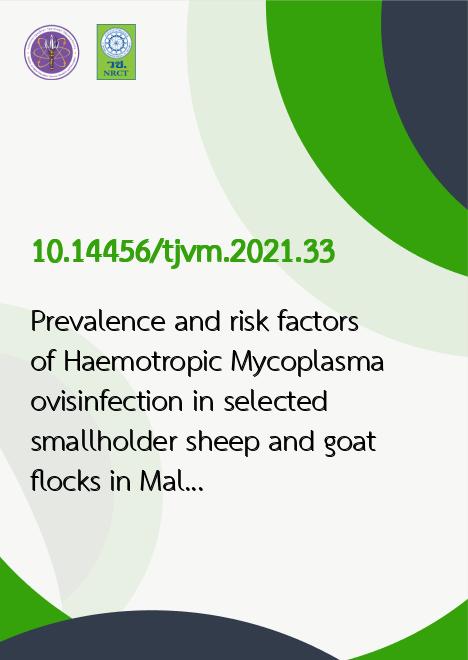
|
Prevalence and risk factors of Haemotropic Mycoplasma ovisinfection in selected smallholder sheep and goat flocks in Malaysia |
|---|---|
| รหัสดีโอไอ | |
| Creator | Faez Firdaus Abdullah Jesse |
| Title | Prevalence and risk factors of Haemotropic Mycoplasma ovisinfection in selected smallholder sheep and goat flocks in Malaysia |
| Contributor | Bura Thlama Paul, Eric Lim Teik Chung, Azlan Che-Amat, Mohd Lila Mohd-Azmi |
| Publisher | Chulalongkorn University |
| Publication Year | 2564 |
| Journal Title | The Thai Journal of Veterinary Medicine |
| Journal Vol. | 51 |
| Journal No. | 2 |
| Page no. | 259 |
| Keyword | Anaemia, Mycoplasma ovis, Prevalence, Risk factors, Severity |
| URL Website | https://he01.tci-thaijo.org/index.php/tjvm/index |
| Website title | https://he01.tci-thaijo.org/index.php/tjvm/index |
| ISSN | 0125-6491 |
| Abstract | Outbreaks of haemotropic Mycoplasma oviscause haemolytic anaemiawith decreased production outcomes and mortality in sheep and goats worldwide but there is a lack of published data on the epidemiology of M. ovisin Malaysia's small ruminant flocks. This preliminary study investigates the prevalence and risk factors of Mycoplasma ovisinfection in selected smallholder farms in Negeri Sembilan state. A total of 341 blood samples was randomly collected from 5 farms between January and December 2019. The farmers also completed a structured questionnaire to provide farm management data and environmental information. Giemsa stained blood smears were examined microscopically to detect M. ovisand classify the infection as mild (1-29% infected red cells), moderate (30-59%) or severe (above 60%). The packed cell volume (PCV) was determined by microhaematocrit centrifugation technique and reported as anaemic or non-anaemic. Microscopic examination of blood smears revealed an overall prevalence of 50.7% (95%CI= 45.5-56.0), and there were higher (p<0.05) numbers of mild (34.3%) than moderate (12.6%) and severe (3.8%) infections. The mean PCV was significantly lower (p<0.05) in animals with severe (22.69%) than mild (29.11%) and moderate (30.53%) infections. Mycoplasma ovisinfection was associated with the breeds physiological status,farm location, management system, farm ownership, frequency of vector control and deworming regime but the risk of infection was higher in Malin sheep (OR=3.97), Boer goats (OR=2.23), pregnant (OR=2.89) and lactating animals (OR= 2.23). The prevalence of M. ovisinfection in smallholder flocks is associated with the breed and physiological status of sheep and goats and may potentially affect production. |
